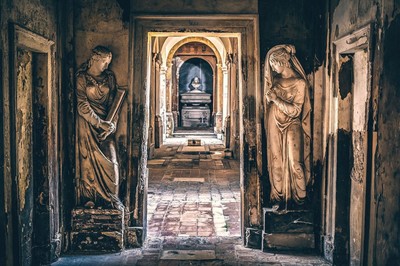Money back guarantee policy!

If you are looking for a place to explore the art, history and culture of Italy, you should visit the Certosa of Bologna, a former Carthusian monastery that became the city's monumental cemetery in 1801. This cemetery, located just outside the walls of the city, near the Sanctuary of the Madonna di San Luca, is a unique museum that showcases the works of many artists from different periods and styles.
## The history of the Certosa
The Certosa of Bologna was founded in 1334 by Enea degli Ordelaffi, lord of Forlì, who donated the land to the Carthusian order. The monastery was dedicated to Saint Jerome (San Girolamo) and became a center of spiritual and cultural life. The church was decorated with paintings by prominent Bolognese artists, such as Bartolomeo Cesi, Elisabetta Sirani, Francesco Gessi and Lorenzo Pasinelli. The wooden choir stalls were carved by Biagio De' Marchi in 1538 after a fire caused by the troops of Charles V. The monastery also had a rich library and a pharmacy.
In 1797, the monastery was suppressed by Napoleon and its assets were confiscated. In 1801, it was converted into a public cemetery by decree of the Cisalpine Republic. The cemetery was designed by Ercole Gasparini, who preserved the original structure of the monastery and added new buildings and porticos. The cemetery became a place where the local nobility and aristocracy displayed their wealth and prestige through monumental tombs and sculptures. It also attracted many visitors from abroad, such as Byron, Dickens, Mommsen and Stendhal, who praised its beauty and romanticism.
## The art of the Certosa
The Certosa of Bologna is home to a vast collection of paintings and sculptures that span from the 14th to the 21st century. You can admire works by almost all the Bolognese artists who were active in the 19th and 20th century, such as Giorgio Morandi, Bruno Saetti, Lucio Dalla and Nunzio Rossi. You can also see works by foreign artists who influenced or were influenced by the local culture, such as Antonio and Bartolomeo Vivarini, Ludovico and Agostino Carracci, Guercino and Ottorino Respighi.
The cemetery is divided into several sections that reflect different artistic movements and trends. The Third Cloister (or Chapel Cloister) is the most representative of the neoclassical style, with tombs painted in tempera or made of stucco and scagliola. The Fourth Cloister (or Colombarium) is characterized by eclectic and oriental influences, with tombs inspired by Egyptian, Greek and Roman motifs. The Fifth Cloister (or Gallery) is dominated by realistic and naturalistic sculptures that depict scenes from everyday life or allegories of death. The Sixth Cloister (or New Gallery) is dedicated to modern and contemporary art, with works that express social and political themes or experiment with new materials and techniques.
The cemetery also hosts some important figures for the local and national history, such as Marco Minghetti (a statesman), Giosue Carducci (a Nobel laureate for literature), Riccardo Bacchelli (a writer), Carlo Broschi (an opera singer known as Farinelli), Giuseppe Grabinski (a Polish general), Taddeo Matuszevic (a Polish prime minister), Maserati (the founders of the car company), Ducati (the founders of the motorcycle company), Weber (the founders of the grill company) and Zanichelli (the founders of the publishing house).
## How to visit the Certosa
The Certosa of Bologna is open to visitors every day from 8 am to 6 pm (from November to February) or from 7 am to 7 pm (from March to October). You can access it for free or book a guided tour online on [the official website](https://www.storiaememoriadibologna.it/certosa) or by phone at +39 051 6153370. The entrance is located at Via della Certosa 18. You can reach it by car or by bus (lines 20, 36 or 52).
If you are looking for a hidden gem in Italy that will surprise you with its artistic richness and diversity, you should not miss the Certosa of Bologna. This cemetery is not only a place of rest for the dead, but also a place of inspiration for the living. Don't forget your camera!
Wanna see more? click the link